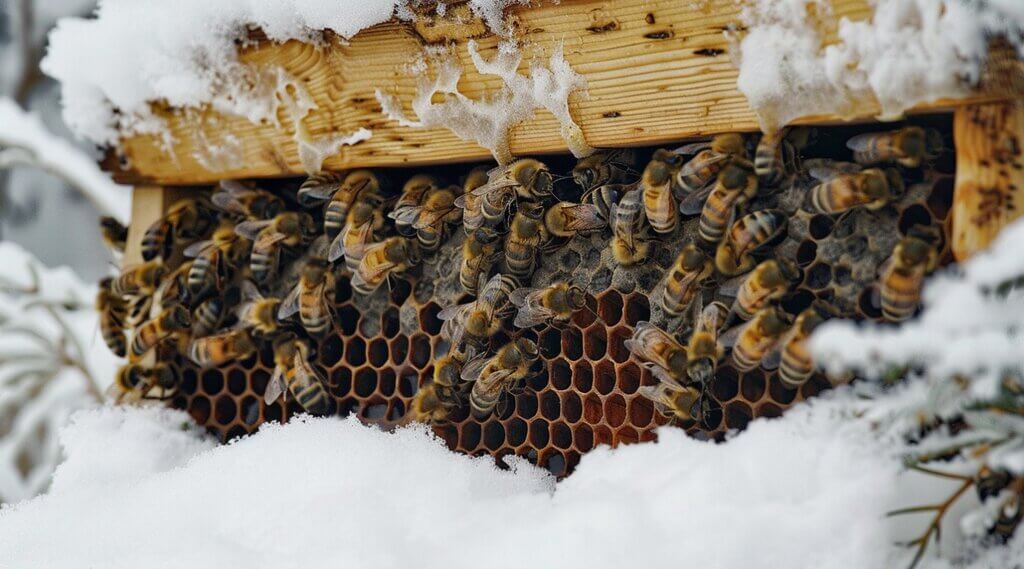Winter brings challenges for bee colonies. Proper insulation is crucial for their survival. Beekeepers must balance warmth, moisture, and optimal hive conditions. This involves understanding winter clusters and choosing the right insulation.
Hive design, insulation materials, and the environment affect colony health. Beekeepers navigate these factors to protect their bees. Each step is vital for the colony's resilience and productivity.
For beekeepers, knowing about the winter cluster is crucial. It helps keep bees alive during cold months. Bees form a special structure. Older bees wrap around younger ones inside the hive. This keeps the hive warm.
The older bees shiver to produce heat. The cluster's size affects its warmth. Bees also slow their metabolism to save energy. They link their hairs together. This reduces heat loss.
Understanding these behaviors is key for beekeepers. It helps them care for their bees in winter.
Beehive insulation is crucial for bee survival in winter. It mimics natural cavities, helping bees adapt to man-made hives. Reverend Langstroth highlighted its importance for cold climates.
Insulation keeps the bee cluster warm, reducing energy use. It's effectiveness is measured by the R-value. Higher R-values mean better insulation. Materials like expanded polystyrene foam are ideal due to their high R-values.
Proper insulation boosts bee health and productivity. Quality materials are key. Regular maintenance is essential for winter survival.
Effective condensation management in winter is crucial for bee health. Condensation forms when hive interior warmth meets cold air, risking bee health by causing moisture to drip on them. This can chill and harm bees.
To tackle this, ensure good hive ventilation. Use insulated hives; they handle condensation better, keeping bees dry and warm. Despite winter, bees need water, making condensation control more critical.

Aim for a ventilated, insulated hive to protect bees in cold months.
Effective space management in beehives is crucial for winter survival. The right hive size ensures proper warmth and resource balance.
Overcrowded or underfilled hives pose risks. They affect temperature regulation and bee cluster cohesion. It's vital to adjust hive configurations for winter.
Larger hives may need extra boxes to maintain warmth in cold climates. Proper insulation reduces energy use and keeps the hive warm.
By managing space and resources wisely, beekeepers support bee health during winter. This prepares the hive for spring productivity.
Every step aims at creating a stable environment for bees. Short, direct sentences convey essential information without fluff. This approach emphasizes the importance of meticulous space management in beehives.
To safeguard bee health during winter, beekeepers employ various insulation strategies. Here's a breakdown:
Grasping R-value importance is key for effective winter beehive insulation. R-value gauges insulation's heat retention capability. Higher R-values mean better insulation.
Naturally, tree cavities outperform standard bee boxes in insulation due to higher R-values. Materials like expanded polystyrene foam enhance insulation, offering superior R-values.
Conversely, low R-values in hive walls lead to quick heat loss, challenging bees' temperature control efforts. Optimal insulation with elevated R-values aids bees in conserving energy, vital for surviving cold.
For winter bee protection, R-value consideration is essential. Selecting high R-value materials ensures bees stay warm, promoting their well-being during winter.
Choosing the right spot for a bee hive is crucial, especially for winter survival. Here's how to do it step by step:
Follow these steps for a suitable hive location. Each point is essential for the bees' winter well-being.
To gauge winter beehive insulation success, beekeepers have several strategies. First, check the hive's temperature stability during winter. Signs of insulation failure include excessive condensation or moisture inside the hive.
Next, observe the bees' behavior and activity. If they seem more active than usual, the insulation might be working well.
Compare honey consumption in insulated versus uninsulated hives. Lower consumption in insulated hives indicates better heat retention. For precise monitoring, use thermal imaging or temperature probes. These tools show heat distribution inside the hive accurately.